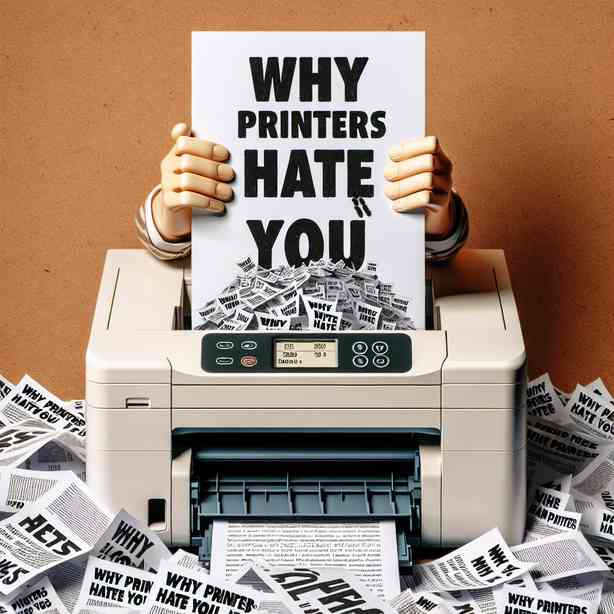
Printers, despite being a crucial tool in our modern lives, often seem to have a contentious relationship with users. There are numerous reasons why printers are perceived negatively, and understanding these reasons can help alleviate frustrations and improve the overall printing experience.
First and foremost, one of the most glaring issues with printers is their tendency to malfunction at the most inconvenient times. For instance, imagine preparing for an important meeting or a school project deadline, only to find that your printer refuses to cooperate. This breakdown often stems from various causes, such as outdated drivers, paper jams, or empty ink cartridges. In many cases, users may lack the technical know-how to troubleshoot these problems effectively, leading to increased stress and frustration.
Furthermore, the complexity of printer settings can add another layer of frustration. Many users expect a straightforward experience, but the reality is that printer setup and configuration can be quite daunting. Options such as print quality, paper type, and color settings often require a certain level of understanding to navigate successfully. When users encounter a problem with these settings, they may feel overwhelmed and unsure how to proceed, causing unnecessary delays.
Moreover, the cost of printing can also lead to dissatisfaction. Ink cartridges and toner can be surprisingly expensive, and users are often taken aback when they realize how quickly they need to be replaced. This recurring cost can make printing feel like an endless expense, which discourages users from pursuing their printing needs. Additionally, the issue of ink wastage—whether from printer head cleaning processes or the phenomenon of “phantom ink” usage—only exacerbates the frustration associated with owning a printer.
Another common complaint regarding printers is the inconsistent print quality. Users may find that the colors are not rendering as expected or that images appear pixelated. This inconsistency can be attributed to a variety of factors, including the quality of the paper being used, the type of ink, or even printer settings that are not configured correctly. Such discrepancies in print quality can lead to dissatisfaction, especially for users who rely on their printers for professional purposes.
Network connectivity issues also play a significant role in the frustrations associated with printers. In an increasingly wireless world, users often prefer using networked or wireless printers. However, these devices can occasionally disconnect from Wi-Fi networks or face compatibility issues, making it difficult for users to print from multiple devices seamlessly. This experience can leave users feeling helpless, especially when they have no immediate solutions at hand.
In addition, many users also grapple with the printer’s physical size and how it fits into their workspace. The purchase of a printer often requires consideration of real estate on desks or in home offices, and larger models may not fit comfortably in smaller work environments. This aspect adds another level of complexity, particularly for users in shared spaces or those who travel frequently for work.
Another reason why users may feel negatively toward printers is the inherent frustration of maintenance. Regular maintenance is crucial for keeping printers functioning optimally, yet many users may not be aware of the importance of cleaning printer heads, regularly changing ink, or performing automated maintenance tasks. When these tasks are overlooked, users may face unexpected issues, prompting feelings of annoyance and resentment toward their devices.
Additionally, there’s the daunting prospect of software compatibility. Printers often require specific drivers or software to operate correctly with computers, and sometimes, updates can cause these drivers to become incompatible. When users upgrade their operating systems or software, they may find themselves facing an uphill battle to ensure that their printer continues to work. The constant concern over software compatibility can erode the user’s trust in their printer, leading to animosity between the user and the device itself.
The emotional aspect of technology cannot be dismissed either. Users often invest their time and money into printers, expecting them to work flawlessly. However, when common issues arise, it can feel like a betrayal. This emotional investment leads to heightened frustration and disappointment when technical difficulties occur, further deepening the perceived animosity between users and their printers.
To improve the relationship between printers and users, it’s essential for manufacturers to focus on creating more user-friendly devices. This includes providing clear instructions, offering comprehensive customer support, and developing intuitive software that assists users in troubleshooting common issues. Additionally, advancements in technology that promote sustainability, such as eco-friendly printing practices and more efficient use of ink, can enhance the printing experience and alleviate some of the frustrations associated with ownership.
In conclusion, while printers may often seem like antagonists in our everyday tasks, recognizing the underlying issues can help us manage expectations and improve our experiences. By understanding the reasons behind common frustrations and taking proactive measures to mitigate them, users can foster a more positive relationship with their printers. Through ongoing improvements in printer technology and user support, it’s possible for printers to become more reliable allies in our daily lives. By addressing the concerns that contribute to user dissatisfaction, we can work towards ensuring that printers truly serve as helpful tools rather than sources of irritation.


